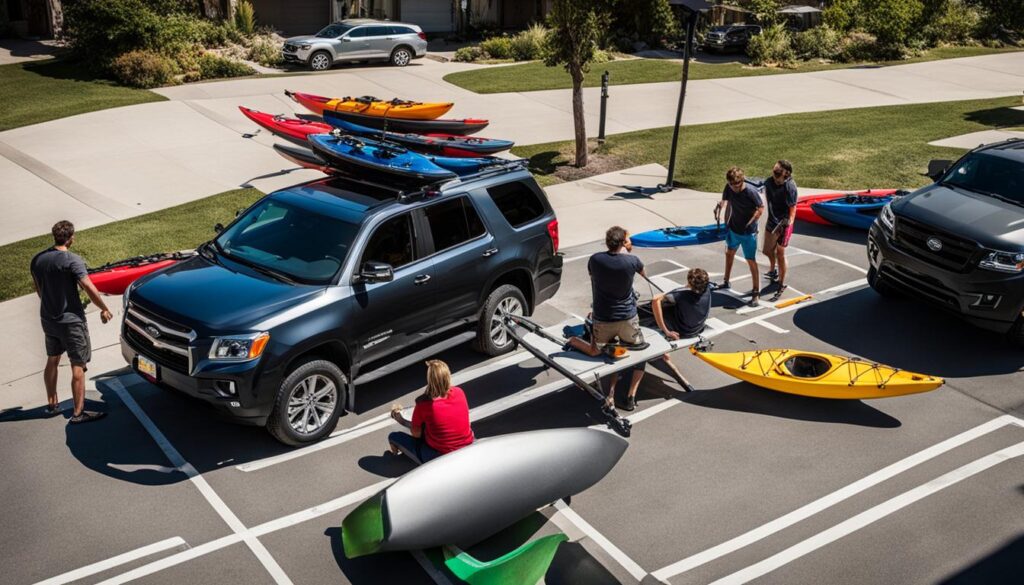Efficiently unloading kayaks after a trip is crucial to ensure a swift, safe, and hassle-free experience. To achieve this, consider using kayak unloading aids and efficient kayak unloading tools. These tools can simplify the process and make it more efficient, saving you time and effort. Proper unloading techniques for heavy kayaks are also important to prevent injuries and damage. By following these tips, you can unload your kayak efficiently and enjoy a stress-free experience.
Key Takeaways:
- Utilize kayak unloading aids and efficient kayak unloading tools to simplify the unloading process.
- Follow proper techniques for unloading heavy kayaks to prevent injuries and damage.
- Ensure a swift and hassle-free experience by unloading your kayak efficiently.
- Consider the weight and balance of your kayak when unloading to maintain safety.
- Prioritize your own well-being by using proper lifting techniques and precautions with kayak components.
Tips for Loading Kayaks onto Truck Beds for Efficient Transportation
Loading kayaks onto truck beds is a popular and affordable method of kayak transportation. Whether you’re heading to your favorite nearby lake or embarking on a cross-country adventure, properly loading your kayak onto the truck bed is crucial for efficient and safe transportation.
One important consideration is ensuring that the weight of the kayak is properly supported to prevent any damage during transportation. Utilizing kayak bed extenders can provide the extra space needed to securely and stably load your kayak onto the truck bed. These extenders attach to the end of the truck bed, allowing the kayak to rest horizontally and evenly distribute its weight.
When loading the kayak, it’s essential to position it correctly to maintain stability throughout the journey. Centering the kayak on the truck bed and securing it with reliable straps or tie-downs will help prevent any shifting or movement during transportation.
Pro Tip: Before loading your kayak, make sure to clear the truck bed of any debris and secure any loose items that might cause damage or interference.
Table: Comparison of Kayak Bed Extenders
| Brand | Material | Max Load Capacity | Adjustability |
|---|---|---|---|
| Brand A | Steel | 500 lbs | Adjustable width and height |
| Brand B | Aluminum | 400 lbs | Adjustable width |
| Brand C | Composite | 600 lbs | Non-adjustable |
Table: Comparison of Kayak Bed Extenders
- Brand A offers a robust steel construction and adjustable width and height, making it suitable for a variety of truck bed sizes and kayak types.
- Brand B, made of lightweight aluminum, provides good load capacity and adjustable width to accommodate different truck beds.
- Brand C, with a composite material, boasts the highest load capacity but lacks adjustability, meaning it may not fit all truck bed sizes.
By following these tips and utilizing kayak bed extenders, you can confidently load your kayak onto a truck bed for efficient and safe transportation, allowing you to focus on the exciting adventures ahead.

Efficient Techniques for Unloading Kayaks from SUVs and Roof Racks
Unloading kayaks from SUVs and roof racks can be a challenging task, but with the right techniques and tools, you can make the process efficient and hassle-free. Using kayak unloading systems designed for cars is one effective method to simplify the unloading process. These systems typically consist of rollers or slides that are mounted onto the roof racks or the back of SUVs, allowing you to slide the kayak off smoothly.
Kayak rollers are another handy accessory that can make unloading easier. These simple devices attach to the rear of your vehicle or roof racks and provide a smooth surface to slide the kayak onto. With the help of kayak rollers, you can avoid straining yourself and save time unloading your kayak.
Using kayak unloading systems designed for cars and kayak rollers can make unloading from SUVs and roof racks a breeze.
Additionally, it is important to ensure that your kayak is securely fastened to the roof rack or SUV before unloading. Double-check the straps and tie-downs to ensure they are tight and properly secured. This will prevent any unexpected movement of the kayak during the unloading process, ensuring both your safety and the protection of the kayak.
By incorporating these efficient techniques and tools, such as kayak unloading systems and rollers, you can unload your kayaks from SUVs and roof racks with ease and efficiency. Remember to always prioritize safety and take necessary precautions to prevent injuries and damage to your kayak. With the right approach, unloading kayaks can be a quick and stress-free experience, allowing you to spend more time on the water.
Table: Comparison of Kayak Unloading Systems for Cars
| Product | Description | Price |
|---|---|---|
| Car Kayak Slide | A slide system that attaches to the rear of your car, allowing you to slide the kayak off smoothly. | $99.99 |
| Roof Rack Roller | A roller device that attaches to the roof rack, providing a smooth surface to slide the kayak. | $59.99 |
| Kayak Rear Loader | A rear-mounted loader that lifts the kayak onto the roof racks, making unloading easier. | $129.99 |
Table: A comparison of kayak unloading systems for cars.
Steps for Safely Unloading Tandem Kayaks and Heavy Kayaks from Vehicles
If you’re planning to unload tandem kayaks or heavy kayaks from your vehicle, it’s important to follow specific steps to ensure safety and prevent any damage. These larger kayaks require extra care and attention during the unloading process. Here are some steps you can take to unload tandem kayaks and heavy kayaks from your vehicle safely:
Step 1: Get Assistance
First and foremost, it’s crucial to involve another person in the unloading process. Having someone assist you not only makes it easier to handle the weight of the kayak but also helps maintain balance during the unloading process. Together, you can coordinate and communicate effectively to ensure a smooth and safe unloading experience.
Step 2: Use Proper Lifting Techniques
When unloading tandem kayaks or heavy kayaks, it’s essential to use proper lifting techniques to avoid strain or injuries. Make sure to bend your knees and use your legs, not your back, to lift the kayak. Encourage your partner to do the same. This technique helps distribute the weight properly and reduces the risk of injury.
Step 3: Secure Rudder and Other Components
Before unloading your tandem kayak or heavy kayak, double-check that all components, such as rudders, are properly secured. Secure any loose items inside the kayak as well. This step ensures that nothing gets damaged or lost during the unloading process.
Step 4: Communicate and Coordinate
Clear communication and coordination between you and your partner are key to a safe and efficient unloading process. Before you start unloading, establish a plan and go over it together. Use verbal cues or hand signals to communicate when to lift, lower, or adjust the kayak. This will help you work in sync and avoid any accidents or mishaps.
By following these steps, you can unload tandem kayaks and heavy kayaks from your vehicle safely and efficiently. Remember to prioritize safety and take your time during the unloading process. With proper technique and assistance, you can enjoy your kayaking adventures without any worries.

Efficient Techniques for Unloading Kayaks Using Carts and Other Accessories
Unloading kayaks without assistance can be challenging, but with the right techniques and accessories, it can be done efficiently. One popular method is using kayak unloading carts, which are designed to make transporting your kayak from the vehicle to the water easier. These carts typically feature sturdy wheels and a supportive frame that can handle the weight of the kayak. Simply place your kayak onto the cart, secure it with straps, and effortlessly roll it to your desired location. This method is particularly helpful for one-person unloading, allowing you to save time and effort.
Aside from carts, there are other useful accessories that can aid in the unloading process. Straps and harnesses, for example, can provide additional support and stability when moving your kayak. By securely attaching these accessories to your kayak and yourself, you can maintain control and prevent any mishaps during the unloading process. Remember to choose high-quality straps and harnesses that are specifically designed for kayak transportation to ensure maximum safety.
Before unloading your kayak, it is important to choose a suitable location. Look for a smooth and level surface near the water where you can easily maneuver your kayak. Make sure there are no obstacles or hazards that could potentially damage your kayak during the unloading process.
Common Mistakes to Avoid
- Using inadequate or poorly constructed unloading carts that may collapse under the weight of the kayak
- Not properly securing the kayak to the cart or using weak straps and harnesses
- Attempting to unload a kayak on uneven or unstable surfaces, increasing the risk of accidents
By following these efficient techniques and utilizing accessories such as kayak unloading carts, straps, and harnesses, you can successfully unload your kayak by yourself without any hassle. Remember to prioritize safety and take your time to ensure a smooth and stress-free unloading experience.
Conclusion
In conclusion, efficiently unloading kayaks is crucial for a seamless post-trip experience. By implementing the tips and techniques discussed in this article, you can ensure a smooth and hassle-free unloading process.
Firstly, utilizing kayak unloading aids and efficient tools can significantly simplify the unloading process, saving you time and effort. These tools are designed to make the task easier and more efficient, allowing you to unload your kayak with ease.
Secondly, it is important to follow proper techniques when unloading kayaks from different types of vehicles. Whether you are unloading from a truck bed, SUV, or roof rack, using the right techniques and tools, such as kayak unloading systems and rollers, can prevent injuries and damage to your kayak.
Lastly, if you find yourself unloading kayaks without assistance, consider using kayak unloading carts and other accessories. These tools can provide the support you need to transport your kayak from the vehicle to the water effortlessly.
Remember to prioritize safety throughout the unloading process and take necessary precautions to avoid accidents. By incorporating these strategies, you can unload your kayaks efficiently and spend more time enjoying the water.
FAQ
What are some tips for efficiently unloading kayaks after a trip?
Consider using kayak unloading aids and efficient kayak unloading tools to simplify the process. Proper unloading techniques for heavy kayaks are also important to prevent injuries and damage.
How can I load my kayak onto a truck bed efficiently and securely?
Ensure that the weight is properly supported and consider using bed extenders if necessary to achieve efficient and safe transportation.
What techniques can I use to unload kayaks from SUVs and roof racks?
Use kayak unloading systems designed for cars, and consider using kayak rollers to slide the kayak off the roof rack or SUV smoothly.
How can I safely unload tandem kayaks and heavy kayaks from vehicles?
Involve another person in the unloading process for assistance and balance. Use proper lifting techniques and take precautions with rudders and other kayak components.
Can I unload kayaks without assistance?
Yes, you can use kayak unloading carts and other accessories such as straps and harnesses to aid in the unloading process.
How can I ensure a smooth and efficient unloading process for my kayaks?
Follow the tips and techniques mentioned in this article, prioritize safety, and take necessary precautions to prevent injuries and damage.





